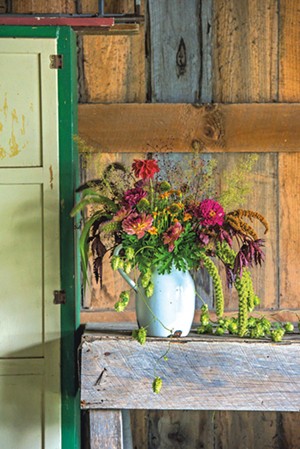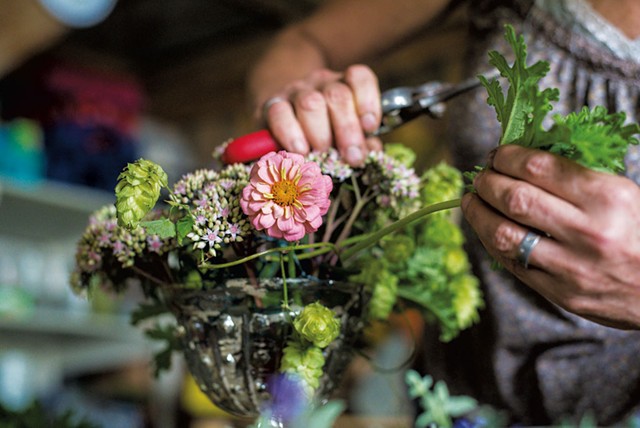
- Glenn Russell
- A flower arrangement by Diana Doll of Stray Cat Flower Farm in Burlington
Days are getting shorter and nights are getting cooler. But for many, fall is the sweetest time of year ... for flowers. Before the frost comes, gardeners like to snip some of the last blossoms and make autumnal arrangements indoors. Don't have a garden? No problem. Local pick-your-own growers and purveyors of the farm-to-table-flowers movement can satisfy your interest in gathering greens.
"Fall is a great time for cut flowers," says Diana Doll of Stray Cat Flower Farm in Burlington. Since she began farming at the Intervale 30 years ago, she's experimented with a variety of flowering plants and grows shrubs, as well, on her two-acre plot. Along with a vase-delivery service, wedding service and selling bouquets to local markets, Doll offers self-guided pick-your-own hours.
"We see a lot of customers who haven't visited a flower farm before," she says. "They're picking directly from the field, and everything will last a lot longer than store-bought bouquets will.
"Getting into the garden and cutting for a bouquet is so wonderful," Doll continues. "Formal training isn't necessary."
So, what might a novice like to know?
Tools
Bring small clippers for soft-stemmed flowers and loppers if you plan to gather larger branches. Don't forget something to hold your cuttings. Bring your own bucket to a pick-your-own farm, or prepare to pay for one on-site. Have a pair of gloves on hand and a notebook to write down the names of plants you're not familiar with (and might want to grow yourself next year).
Containers
Before going out to pick, whether in your backyard, on a flower farm or on the side of the road, give some thought to the containers you want to fill. These can be just about anything: traditional vases, mason jars, vintage jugs, crocks, soup tureens, Grandma's teapot, even teacups. Just make sure your container is watertight.
Arranging
Regardless of your container's size, general design rules apply: thrillers, fillers and spillers. Thrillers give height and overall structure and can be branches or tall stems; fillers give mass and bulk; and spillers add texture and soften edges.
Design with your container in mind, and cut stems that complement the shape, using your own sense of proportion. If possible, spread cut material out on a flat surface and organize by plant type. Work quickly, stripping bottom leaves off of stems as you go. A floral preservative will help prolong the blooms. (Look online for DIY recipes.)
"Use a wire mesh ball to support stems in small containers," says Doll. She uses a coated chicken wire nest to hold flowers upright in a candy dish. Floral tape and regular tape can also be used to form a grid over the top of a vessel to hold stems.
Metal or glass frogs — little cages made with wire, sharp pointy spikes or discs with holes — are also made for vases to keep plant material in place.
The Blossoms

- Glenn Russell
- Diane Doll preparing an assortment of fresh-cut flowers at Stray Cat Flower Farm in Burlington
Zinnias, cosmos — these we know and love. But what are some other flowers to discover and grow?
Dahlias are one of the most popular late-season cut flowers, and for good reason. With shapes ranging from pom-pom to cactus spike and petals in nearly every color, they're fun and fabulous. If you grow your own, cut the buds that are just opening to ensure a long bloom period.
Ageratum Blue Horizon is a great filler; try growing it in vegetable beds with purple heliotrope, black and blue salvia, and orange calendula.
Benary's Giant Series zinnias are tried and true. By October these stalwarts are fully branched, with raspberry, red, carmine rose, bright pink, wine and purple double flowers on plants that grow as high as four feet. (These may require staking mid-season.)
If you're looking for something totally different, try growing amaranth. Red Spike amaranth produces burgundy flower panicles that resemble feather dusters. Old favorite Love-Lies-Bleeding amaranth has unusually long, cascading strands and is best used in a tall display.
Hibiscus Mahogany Splendor is a favorite at Stray Cat Flower Farm. It's a dramatic plant with cut leaves that resemble a Japanese maple. The dark foliage makes a good backdrop for sunflowers and tawny ornamental grasses.
By late September, most perennials have come and gone, but there are a few late bloomers, most notably Japanese anemone, New England asters, cold-hardy chrysanthemums and sedum.
Of these, sedum is a standout. Both Autumn Joy and Matrona cultivars have exceptional vase life and look good with Mexican sunflowers, black-eyed Susans, dahlias and thin sprays of Russian sage.
While color and shape are important, scent is, too. Fragrant mints and pelargoniums (a type of scented geranium) are good to use. Geranium Citronella has a lemony smell — snip some branches and try combining them with purple basil and a yellow gem marigold for a kitchen windowsill bouquet.
Coneflowers are a common garden plant offering four seasons of interest. In late September, cut the stems down and pull the petals away from the cone. Use the rigid cones to add texture and density to bouquets.
Extras
Wild blue indigo plants produce showy seedpods, and many ornamental grasses are good to cut for their interesting seed heads. Purple fountain grass is one of the best for its soft, foxtail-like spikes.
Don't forget about berries, leaves and stems. Doll often collects branches such as oak and maple to give structure to floral designs. "Sumac is interesting," she suggests, especially for its deep coral seedpods.
When picking your own, look for shrubs with interesting foliage. Purple ninebark, a multistemmed native shrub, looks great paired with panicle hydrangea Little Lime in, say, a large bucket by the front door. Both are common foundation plants and can take some pruning, especially on older canes.
Crabapples are lovely; strip leaves away if you prefer. Winterberry, the deciduous holly that's native to the eastern U.S., produces red or orange fruits that color up once the cold weather hits.
It's all good. Experiment as you go, and enjoy the harvest season.











Comments
Comments are closed.
From 2014-2020, Seven Days allowed readers to comment on all stories posted on our website. While we've appreciated the suggestions and insights, right now Seven Days is prioritizing our core mission — producing high-quality, responsible local journalism — over moderating online debates between readers.
To criticize, correct or praise our reporting, please send us a letter to the editor or send us a tip. We’ll check it out and report the results.
Online comments may return when we have better tech tools for managing them. Thanks for reading.